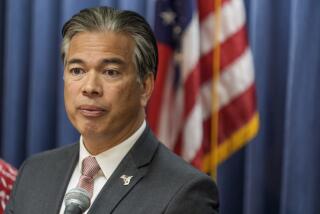Zacarias Releases Plan to Reorganize School District
- Share via
Embattled city schools Supt. Ruben Zacarias on Tuesday abruptly unveiled a plan to reorganize the Los Angeles Unified School District, releasing it to the public before presenting it to school board members.
Zacarias’ plan, which some supporters say has the backing of key Latino elected officials, would use the private sector as a model to streamline the bureaucracy and would divide the vast public school system into at least a dozen semiautonomous “mini-districts.”
He described his plan, which he finished Monday night, as a “bridge to consensus” that could span the chasm between himself and the Board of Education, which recently moved to curtail his authority.
“They want me to be the visionary. They want me to be creative,” he said, his voice swelling with emotion. Pointing to an overhead projector chart of his reorganization plan, he proclaimed, “There it is.”
In other developments Tuesday, the board:
* Postponed a scheduled quarterly evaluation of Zacarias for two weeks.
* Placed on administrative leave six of the nine employees accused by the district’s top auditor of failing to properly oversee planning of construction for the Belmont Learning Complex. Two others, Chief Administrative Officer David Koch and General Counsel Richard Mason, have been offered buyout packages. One has left the district.
Asked if his plan was meant to rally supporters in his fight with the board, Zacarias said: “No, it’s not a call to arms. This is not meant to be a divisive, me versus them. Frankly, I’m somewhat offended by that notion.”
Zacarias, who took office in July 1997, began talking about the need for a district reorganization only two weeks ago. But on Tuesday, he said that the plan, which lacked detail, has been in the works for months.
He denied a connection to the school board’s recent appointment of real estate attorney Howard Miller as chief executive.
Charged with reorganizing the district, Miller was given control of all departments and divisions. Although he was supposed to report to Zacarias, all other employees were to take orders only from him.
Zacarias has refused to accept the appointment, saying that it would render him superfluous and vulnerable to being forced out. Neither he nor the school board have agreed to alter their positions.
That rift has all but paralyzed district operations and angered Latino elected officials and civil rights leaders who believe they should have been involved in the process that led to Miller’s appointment. District staff are unsure who is running the district.
On Tuesday, the reorganization plan seemed to add to the chaos, with some members faulting Zacarias’ methods and timing.
“I find it very upsetting that the superintendent did not give us an advance look at his plan,” board member Valerie Fields said, after the plan was announced to the public before being presented to the board.
She and other board members were scheduled to review Zacarias on Thursday but delayed the action.
When asked the reason for the delay, member David Tokofsky said, “The evaluation takes more time than the new board members understood. It’s a very cumbersome project.”
But member Caprice Young said the delay was requested by Zacarias, who wanted “a chance to see what he’s done in each of the criteria.”
Zacarias had complained that he was to be evaluated without having received finalized goals and objectives.
The evaluation, which would have created a baseline on which to judge his future performance, was to have been the first since a slate of reform-minded candidates took office this summer.
Although many questioned the timing of Zacarias’ reorganization plan, board member Victoria Castro said: “Ruben’s plan should be looked at as a compromise that will get us out of the controversy we are in now.”
She conceded, however, that the board needed advance notice. “It was an abrupt announcement, probably because of the pace of things in the district right now,” she said.
Under Zacarias’ plan, the superintendent would return to the top of the organizational structure, with three deputies and an interim organization officer reporting to him.
Miller would be demoted to one of the deputy positions, chief of “capital assets and facilities services” in charge of building new schools and overseeing the environmentally plagued Belmont Learning Complex and the South Gate school construction sites.
Zacarias said he wouldn’t oppose the idea of Miller becoming the interim reorganization officer instead. In that position, Miller would be in charge of implementing Zacarias’ restructuring plan instead of his own.
Miller, who is working on his own reorganization plan, declined to comment on any aspect of Zacarias’ proposal.
The reorganization plan would create 12 semiautonomous mini-districts within Los Angeles Unified. Zacarias said that the mini-districts would be more efficient than the current system of 27 administrative “clusters,” each built around a high school, and that the greater autonomy of each mini-district would allow more responsiveness to community needs.
“The purpose of having these . . . 12 districts is so we can have clear and more direct lines of accountability,” he said.
The plan also calls for bench-marking student and teacher performance, setting new goals for improvement, and routine assessments of every functional unit.
All groups involved in academic achievement would be required to make written recommendations to increase student test scores by at least 5% each year for five years. As it stands, Zacarias has sought to raise student test scores by two percentile points a year. Critics have pointed out, however, that such gains can be attributed to mere familiarity with the test-taking procedure.
The private sector would be used as a model in the reorganization, Zacarias said, striving for greater efficiency, a smaller bureaucracy, increased productivity through computerization, and a restructuring of labor contracts to increase pay but give the district more efficient work rules.
He said the first phase of his plan--the administrative reorganization--would take effect at the end of this year, and the rest by the beginning of the next school year. However, he said, he intends to hold hearings so the public would have a voice in the plan.
He added that he hoped for support from the Board of Education. “It’s important that we join hands with this restructuring,” he said.
Zacarias said he was acting now, in the midst of a power struggle, rather than months ago, because the turmoil had helped create a consensus in favor of reform.
“This is only as good as everybody buying into it,” he said.
(BEGIN TEXT OF INFOBOX / INFOGRAPHIC)
Call for Change
New structures:
Twelve semiautonomous “ mimi-districts” would be created.
Administration:
Supertendent would return to the top post. Deputies would suport him.
Leadership:
Chief Executive Howard Miller would be demoted to deputy.
Students:
Test scores would be expected to increase by 5 percentile points every year to five years.
*
Times staff writer Mitchell Landsberg contributed to this report.
More to Read
Sign up for Essential California
The most important California stories and recommendations in your inbox every morning.
You may occasionally receive promotional content from the Los Angeles Times.











